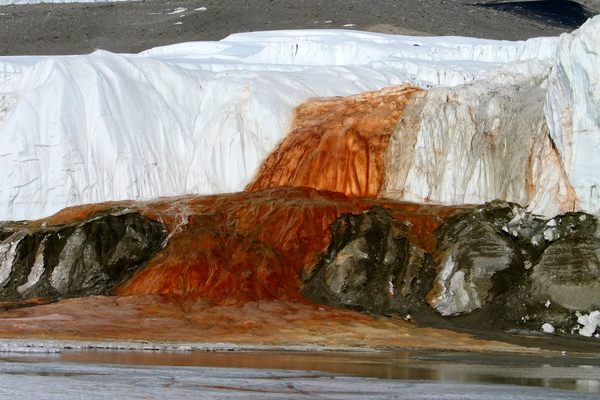Gas Trapped in Antarctic Ice Recorded the Mass Death of 56 Million People
Plagues, war, and genocide were literally frozen in time.
A recent discovery deep within Antarctica’s ice has given scientists new clues about major world events. At the bottom of the globe, data from the last 800,000 years has been locked into the polar ice caps dubbed the Law Dome and WAIS Divide.
As snow falls year after year in the coldest place on the planet, the layers are compressed into solid ice. That snow contains particulates and chemicals that get trapped within the layers—which reflects what was going on in the world at that time. “As the snow was falling, it also trapped pockets of air,” says Amy King, a research scientist for the British Antarctic Survey. By drilling into the ice, scientists can extract a long cylinder called an ice core to analyze the air and gasses from the past. “Those are a sample of the atmosphere as it was at that time. So as we drill down into the ice, we retrieve these gradually older and older air samples, trapped as bubbles, and we can therefore measure older and older atmospheric histories.”
These ice cores reveal crucial missing data. “In most parts of the world, people have been making direct measurements of climate using thermometers and other instruments since the 19th century at best,” says Carrie Morrill, the director of World Data Service for Paleoclimatology at NOAA’s National Centers for Environmental Information. But there is no recorded data before that time period. That’s where ice cores come in.

The air trapped in the ice can reveal information about things like droughts and volcanic eruptions. “Measurements of sulfate from ice cores mark large volcanic eruptions in the past. By comparing sulfate in ice cores in Greenland and Antarctica, scientists can deduce which hemisphere the eruption originated in and how large the eruption was,” says Morrill. These frozen records also show the progress of human industry. “Traces of metals such as copper and lead in ice cores provide evidence for mining and smelting operations from past civilizations, including the Greeks, Romans, and Incas, as well as for our use of leaded gasoline after the 1960s.”
And for King, the ice cores reveal another deadly side of human activity. In a recently released study from those ice cores, King and a team of researchers from the University of Cambridge and the British Antarctic Survey were able to see the impact of colonization on human populations.
King and her team focused on levels of carbon dioxide trapped in the ice. The gas, which is emitted by humans on exhalation and used by plants to create oxygen, is a key indicator of atmospheric health on planet Earth. “The amount of carbon dioxide in the atmosphere is a balance between the things that emit carbon dioxide and things that absorb carbon dioxide, for example the oceans, forests, and human activities,” says King. That balance is often upset by human activity. In the case of this study, that human activity was colonization.

When Europeans arrived to the Americas in the 15th century, they brought diseases like measles and smallpox to Indigenous people with no natural defenses, as well as war and colonial genocide. Within 150 years of that arrival, it is estimated that 56 million Indigenous people perished.
This massive reduction in human population was recorded in Antarctica, says King. Places Indigenous people once lived, worked, and farmed were abandoned, and the fabric of the planet was altered.
“We know that forests absorb carbon dioxide, thus reducing the amount of carbon dioxide in the atmosphere. So when there was a large population decline due to epidemics, a lot of natural forest could grow back over previous agricultural land.” The presence of more forested land meant more CO2 was absorbed by those plants, thus reducing carbon dioxide levels across the world. “This change in the atmosphere is recorded in our ice bubbles,” says King.

While widespread disease once had the ability to alter Earth’s atmosphere, the equation isn’t so simple anymore. The most recent pandemic also resulted in millions of deaths, but that event likely won’t be locked within sheets of ice. For one thing, the total of fatalities was a smaller percentage of today’s larger global population. Also, “there are much larger background emissions of carbon dioxide today compared to the 16th and 17th century,” says King. “Although a lot of things changed for many people during the pandemic, most of the biggest emitters didn’t stop.” We’re currently still experiencing a rapid increase in carbon dioxide in the atmosphere.
King says that her team’s findings show just how much human actions matter. She explains, “Human changes at the time caused a noticeable effect on our atmosphere, showing how influential humans were even at this early time.”














Follow us on Twitter to get the latest on the world's hidden wonders.
Like us on Facebook to get the latest on the world's hidden wonders.
Follow us on Twitter Like us on Facebook